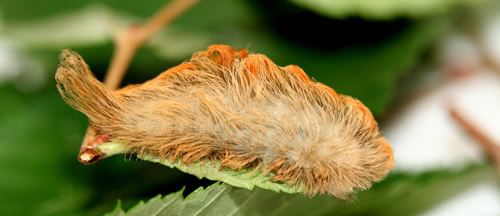By Reba Kocher
Listen to this post here:Stinging_Caterpillars.mp3
I know that I said I would give you all a break from Lepidopteron, but I lied. I can’t help it; they are some of my favorite creatures. When I was looking for the monarch caterpillars today, I stumbled upon a Milkweed Tussock Moth caterpillar. Milkweed Tussock caterpillars are really hairy and, in my opinion, kinda cute. They, however, should not be touched with bare hands! The reason I am bringing us back to caterpillars has more to do with the safety of visitors than it does with my fascination with them. Several people who visit bring their children, and I want to warn you that there are some stinging caterpillars, like the Milkweed Tussock, living here.

A Milkweed Tussock caterpillar with stinging hairs. Photo by Reba Kocher, at Clary Gardens.
I’m sure that many of you have played with woolly worms as children (I know I have!), which turn into Isabella Tiger Moths. They are big and hairy, usually black with a reddish-brown band. There are several types of fuzzy caterpillars that are like the woolly worm, but there are also fuzzy stinging caterpillars to watch out for. Stinging caterpillars have urticating, or nettling, hairs that either puncture the skin and inject a venom or puncture the skin and then break off into the new wound. Their hairs are either long and flexible or in stout bristles, but this does not dictate how the hair will sting you. For example, there are several species of tussock caterpillars with long flexible hair, but some of them with inject venom and others will break off into the wound.

A cute, harmless woolly worm. Photo by the Old Farmer's Almanac.
Why do some caterpillars sting? It is, as I’m sure you hypothesized, to keep them safe. A caterpillar, like the monarch butterfly caterpillars, are soft and squishy with no defense mechanism--other than their bitter flavor and poisonous bodies (if ingested). These caterpillars are able to protect themselves from predators with ease. If you were to pick up that Milkweed Tussock hanging out on our milkweed, you would experience great pain and, depending on your sensitivity, break out in a rash and/or have severe swelling. Some people have also needed to go to the emergency room! Please teach your children not to handle any kind of hairy or spiny caterpillars. If you do not know for sure that the caterpillar is harmless, do not touch it! Keep yourself and your loved ones safe.
If you or someone you know touches a stinging caterpillar, here is recommended treatment from the U.S. poison control https://www.poison.org/articles/2014-jun/caterpillar-stings
Check out the BYGL OSU link to see more photo of native Ohio stinging caterpillars. https://bygl.osu.edu/https://bygl.osu.edu/index.php/node/903

Puss Caterpillar (photo by Donald W. Hall, University of Florida).
References & Further Reading
https://entomology.ca.uky.edu/ef003
https://news.nationalgeographic.com/news/2014/09/toupee-caterpillar-venomous-animal-weird-insect/
https://bygl.osu.edu/index.php/node/903
